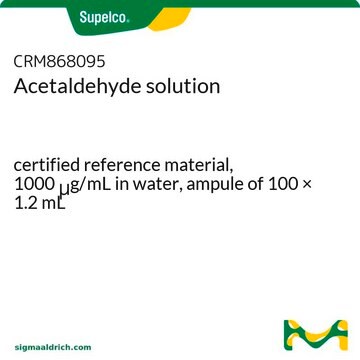00070
Acétaldéhyde
puriss. p.a., anhydrous, ≥99.5% (GC)
Synonyme(s) :
Éthanal
About This Item
Produits recommandés
Source biologique
synthetic
Niveau de qualité
Qualité
anhydrous
puriss. p.a.
anhydrous
Densité de vapeur
1.52 (vs air)
Pression de vapeur
14.63 psi ( 20 °C)
Pureté
≥99.5% (GC)
Forme
liquid
Température d'inflammation spontanée
365 °F
Limite d'explosivité
60 %
Impuretés
≤0.5% free acid (as CH3COOH)
Résidus d'évap.
≤0.002%
Indice de réfraction
n20/D 1.332 (lit.)
n20/D 1.332
Point d'ébullition
21 °C (lit.)
Pf
−125 °C (lit.)
Densité
0.785 g/mL at 25 °C (lit.)
Traces de cations
Al: ≤0.5 mg/kg
Ba: ≤0.1 mg/kg
Bi: ≤0.1 mg/kg
Ca: ≤0.5 mg/kg
Cd: ≤0.05 mg/kg
Co: ≤0.02 mg/kg
Cr: ≤0.02 mg/kg
Cu: ≤0.02 mg/kg
Fe: ≤0.5 mg/kg
K: ≤0.5 mg/kg
Li: ≤0.1 mg/kg
Mg: ≤0.1 mg/kg
Mn: ≤0.02 mg/kg
Mo: ≤0.1 mg/kg
Na: ≤0.5 mg/kg
Ni: ≤0.02 mg/kg
Pb: ≤0.1 mg/kg
Sr: ≤0.1 mg/kg
Zn: ≤0.1 mg/kg
Température de stockage
2-8°C
Chaîne SMILES
CC=O
InChI
1S/C2H4O/c1-2-3/h2H,1H3
Clé InChI
IKHGUXGNUITLKF-UHFFFAOYSA-N
Vous recherchez des produits similaires ? Visite Guide de comparaison des produits
Catégories apparentées
Description générale
Application
Attention
Mention d'avertissement
Danger
Mentions de danger
Conseils de prudence
Classification des risques
Carc. 1B - Eye Irrit. 2 - Flam. Liq. 1 - Muta. 2 - STOT SE 3
Organes cibles
Respiratory system
Code de la classe de stockage
3 - Flammable liquids
Classe de danger pour l'eau (WGK)
WGK 3
Point d'éclair (°F)
-38.0 °F - closed cup
Point d'éclair (°C)
-38.89 °C - closed cup
Équipement de protection individuelle
Eyeshields, Faceshields, Gloves
Choose from one of the most recent versions:
Déjà en possession de ce produit ?
Retrouvez la documentation relative aux produits que vous avez récemment achetés dans la Bibliothèque de documents.
Les clients ont également consulté
Protocoles
-Tolualdehyde; Valeraldehyde; Isovaleraldehyde
Notre équipe de scientifiques dispose d'une expérience dans tous les secteurs de la recherche, notamment en sciences de la vie, science des matériaux, synthèse chimique, chromatographie, analyse et dans de nombreux autres domaines..
Contacter notre Service technique






